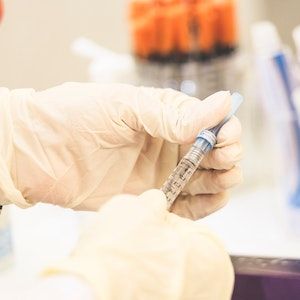Article
Real-World Dupilumab Initiation Linked to Atopic Dermatitis Clearance at 6 Months
Author(s):
An assessment of real-world registry data suggest the biologic provides significant benefit outside of clinical trials.

A real-world assessment of dupilumab (Dupixent) show the biologic agent provides patients with atopic dermatitis consistent clinician- and patient-reported outcomes.
The interim PROSE registry findings, presented at the American Academy of Dermatology (AAD) Virtual Meeting Experience this weekend, complement a litany of clinical trials observing the interleukin-4 and -13 (IL-4; IL-13) inhibitor for atopic dermatitis.
Investigators, led by Jerry Bagel, MD, of the Psoriasis Treatment Center of Central New Jersey, sought the early trends of real-world initiated dupilumab treatment from the PROSE registry—an ongoing, multicenter, longitudinal observational database enrolling atopic dermatitis patients treated with dupilumab in the US and Canada for up to 5 years.
“Randomized dupilumab clinical trials have demonstrated rapid and sustained long-term efficacy with an acceptable safety profile in patients with moderate-to-severe atopic dermatitis; however, real-world data are limited,” Bagel and colleagues wrote.
Their assessment of the registry did not include imputation for missing values. Eligible patients were initiating dupilumab as standard of care for diagnosed atopic dermatitis, but were able to receive marketed drugs as prescribed by clinicians for either their disease or a comorbid condition.
At the data cutoff of July 2019, 315 patients were enrolled. Mean patient age was 42.5 years old, with 44.8% being male, and 59.4% being White. Mean baseline Eczema Area Severity Index (EASI) score was 16.9; duration of atopic dermatitis was 19.7 mean years.
By month 6 of real-world dupilumab care, mean EASI score decreased to 4.4. Mean body surface area affected by atopic dermatitis dropped from 26.8% at baseline to 7.2% at 6 months.
Patient-Oriented Eczema Measure (POEM) scores decreased from 18.5 at baseline to 6.9 at month 6. Investigators additionally observed decreases in Peak Pruritus Numerical Rating Scale (6.9 vs 2.5) and Mean Dermatology Life Quality Index (12.7 vs 4.4) in the observed time period.
“This real-world study demonstrates improvement in atopic dermatitis in adults over the initial 6 months of dupilumab treatment, using investigator-assessed and patient-reported outcomes,” Bagel noted in his presentation.
The study, “Early Trends of Disease Improvement in Adult Patients With Atopic Dermatitis Treated With Dupilumab: Real-World Data From the PROSE Registry,” was presented at AAD VMX.





